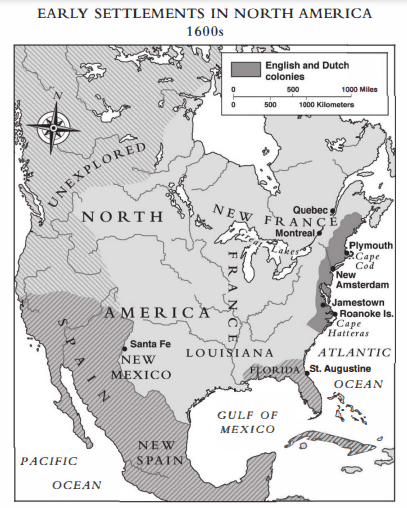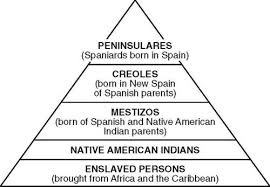
APUSH Period 1 (1491-1607)
Unit 1.1 Before Colonization -
Overall Key Concept 1.1 — As native populations migrated and settled across the vast expanse of North America over time, they developed distinct and increasingly complex societies by adapting to and transforming their diverse environments.
-I. Different native societies adapted to and transformed their environments through innovations in agriculture, resource use, and social structure.
The original discovery of the Americas occurred at least 10,000 years before the birth of European Christopher Columbus. Migrants from Asia crossed a a land bridge that used to connect Siberia and Alaska, which is now submerged due to the rising of sea levels.
The first Americans adapted into their environments and evolved into hundreds of different tribes who spoke different languages and practiced different cultures and traditions. The native population was categorized into three highly developed civilizations…
The Mayas
The Aztecs
The Incas
All three civilizations cultivated crops that provided a stable food supply like maize (Mayas and Aztecs), and potatoes (Incas).
These complex societies mostly disappeared in North America for reasons not understood, but the societies that were left were smaller and less sophisticated than those in Mexico and South America.
Key Concept Simplified: The Native American people organized themselves into diverse cultures depending on where they live.
- Some Native Americans were…
Fishers
Nomadic Hunters (move around a lot to hunt aka hunt buffalo)
Settlers (set up farms)
Unit 1.2 Contact with the Native Americans -
Key Concept 1.2 — Contact among Europeans, Native Americans, and Africans resulted in the Columbian Exchange and significant social, cultural, and political changes on both sides of the Atlantic Ocean.
I. European expansion into the Western Hemisphere generated intense social, religious, political, and economic competition and changes within European societies.
What made the voyage to America possible?
Improvements to technology that came from the Renaissance era like Gunpowder and Sailing compasses.
Improvements in shipbuilding and mapmaking.
The invention of the printing press that aided the spread of knowledge across Europe.
What were the reasons to go to America?
God - Europeans believed it was their duty to bring Christianity to the non-believers of the world.
Glory - Individual explorers competed for fame and honor for both themselves and their countries.
Gold - Nations were always looking for new sources of wealth.
New Routes to Asia -
European Kingdoms needed to find new routes to Asia because their usual route to Asia became blocked when in 1453 when the Ottoman Turks seized control of Constantinople, making their usual route to Asia more expensive and less safe.
In the year 1492 European-Italian Cristopher Columbus arrives in the Americas and later many others travel to America as well, including the Spain, Italy, France, and many other countries in Europe.

The English, French, and Spanish take different approaches in regards to how they treat the Native American population that settle there.
English Policy | - American Indians coexisted, traded, and shared ideas- American Indians taught the settlers how to grow new crops such as corn (maize) and showed them how to hunt in the forests.- At first Native Indians traded and coexisted with the English, but then they saw their way of life becoming threatened because they started taking more land, and forced tribes to move away from the coasts. |
|---|---|
French Policy | - Viewed Native Americans as potential economic and military allies - looking for furs and converts to Catholicism |
Spanish Policy | - The Spanish would treat the Native Americans as laborers, many Native Americans died from forced Spanish Labor- Rigid class systems developed (seen below)- Valladolid debate over the rights of Native Americans |

The Columbian Exchange -
The Columbian Exchange was a period of biological and cultural exchange between the Old and New Worlds following Christopher Columbus's arrival in the Americas in 1492. It involved the exchange of plants, food (beans, corn, sweet and white potatoes, tomatoes, and tobacco) animals, diseases (syphilis, measles, smallpox), and ideas between the two hemispheres.
APUSH Period 1 (1491-1607)
Unit 1.1 Before Colonization -
Overall Key Concept 1.1 — As native populations migrated and settled across the vast expanse of North America over time, they developed distinct and increasingly complex societies by adapting to and transforming their diverse environments.
-I. Different native societies adapted to and transformed their environments through innovations in agriculture, resource use, and social structure.
The original discovery of the Americas occurred at least 10,000 years before the birth of European Christopher Columbus. Migrants from Asia crossed a a land bridge that used to connect Siberia and Alaska, which is now submerged due to the rising of sea levels.
The first Americans adapted into their environments and evolved into hundreds of different tribes who spoke different languages and practiced different cultures and traditions. The native population was categorized into three highly developed civilizations…
The Mayas
The Aztecs
The Incas
All three civilizations cultivated crops that provided a stable food supply like maize (Mayas and Aztecs), and potatoes (Incas).
These complex societies mostly disappeared in North America for reasons not understood, but the societies that were left were smaller and less sophisticated than those in Mexico and South America.
Key Concept Simplified: The Native American people organized themselves into diverse cultures depending on where they live.
- Some Native Americans were…
Fishers
Nomadic Hunters (move around a lot to hunt aka hunt buffalo)
Settlers (set up farms)
Unit 1.2 Contact with the Native Americans -
Key Concept 1.2 — Contact among Europeans, Native Americans, and Africans resulted in the Columbian Exchange and significant social, cultural, and political changes on both sides of the Atlantic Ocean.
I. European expansion into the Western Hemisphere generated intense social, religious, political, and economic competition and changes within European societies.
What made the voyage to America possible?
Improvements to technology that came from the Renaissance era like Gunpowder and Sailing compasses.
Improvements in shipbuilding and mapmaking.
The invention of the printing press that aided the spread of knowledge across Europe.
What were the reasons to go to America?
God - Europeans believed it was their duty to bring Christianity to the non-believers of the world.
Glory - Individual explorers competed for fame and honor for both themselves and their countries.
Gold - Nations were always looking for new sources of wealth.
New Routes to Asia -
European Kingdoms needed to find new routes to Asia because their usual route to Asia became blocked when in 1453 when the Ottoman Turks seized control of Constantinople, making their usual route to Asia more expensive and less safe.
In the year 1492 European-Italian Cristopher Columbus arrives in the Americas and later many others travel to America as well, including the Spain, Italy, France, and many other countries in Europe.

The English, French, and Spanish take different approaches in regards to how they treat the Native American population that settle there.
English Policy | - American Indians coexisted, traded, and shared ideas- American Indians taught the settlers how to grow new crops such as corn (maize) and showed them how to hunt in the forests.- At first Native Indians traded and coexisted with the English, but then they saw their way of life becoming threatened because they started taking more land, and forced tribes to move away from the coasts. |
|---|---|
French Policy | - Viewed Native Americans as potential economic and military allies - looking for furs and converts to Catholicism |
Spanish Policy | - The Spanish would treat the Native Americans as laborers, many Native Americans died from forced Spanish Labor- Rigid class systems developed (seen below)- Valladolid debate over the rights of Native Americans |

The Columbian Exchange -
The Columbian Exchange was a period of biological and cultural exchange between the Old and New Worlds following Christopher Columbus's arrival in the Americas in 1492. It involved the exchange of plants, food (beans, corn, sweet and white potatoes, tomatoes, and tobacco) animals, diseases (syphilis, measles, smallpox), and ideas between the two hemispheres.
 Knowt
Knowt